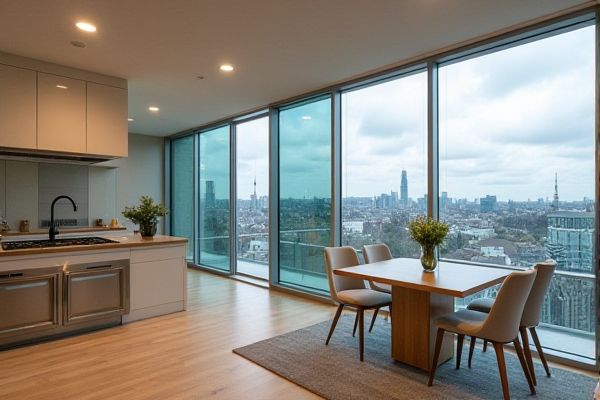
Glass infill panels offer a sleek, modern aesthetic with natural light transparency, enhancing spaciousness and style, while metal infill panels provide superior strength, durability, and a variety of finishes for industrial or contemporary designs. Discover how your choice between glass and metal infill panels can impact safety, maintenance, and visual appeal by reading the full article.
Table of Comparison
| Feature | Glass Infill Panels | Metal Infill Panels |
|---|---|---|
| Material Composition | Tempered or laminated glass | Steel, aluminum, or stainless steel |
| Durability | Moderate; prone to cracking on impact | High; resistant to impact and corrosion |
| Maintenance | Requires regular cleaning to avoid stains | Low maintenance; may need occasional rust prevention |
| Appearance | Transparent, modern look with natural light flow | Opaque, industrial or decorative finishes available |
| Privacy | Low; can be frosted or tinted for privacy | High; solid panels block visibility |
| Installation | Fragile; needs careful handling | Robust; easier to install and secure |
| Cost | Generally higher due to glass processing | Typically lower, depending on metal type |
| Common Uses | Balconies, staircases, partitions for aesthetic appeal | Industrial, security barriers, fencing, structural infill |
Introduction to Infill Panels
Infill panels serve as essential components in balustrades, fences, and partitions, providing both safety and aesthetic appeal. Glass infill panels offer transparency, modern design, and natural light penetration, enhancing visual openness and elegance. Metal infill panels, typically crafted from aluminum or steel, deliver superior strength, durability, and a variety of design patterns, making them ideal for robust, secure installations tailored to your specific architectural style.
Overview of Glass Infill Panels
Glass infill panels offer a sleek, modern aesthetic with transparency that enhances natural light and visibility in architectural designs. These panels are typically made from tempered or laminated glass, providing durability, safety, and resistance to impact and weather conditions. Your choice of glass infill panels can improve the visual appeal and openness of spaces while maintaining structural integrity.
Overview of Metal Infill Panels
Metal infill panels offer superior durability and strength compared to glass, making them ideal for high-traffic or industrial environments. Their ability to withstand impact, weather conditions, and corrosion ensures long-lasting performance with minimal maintenance. Choosing metal infill panels can enhance your structure's safety and provide a modern, sleek aesthetic.
Key Differences Between Glass and Metal Infill Panels
Glass infill panels offer transparency and natural light infiltration, enhancing aesthetic appeal and openness in architectural designs, while metal infill panels provide superior durability, strength, and security with various finishes like aluminum, steel, or wrought iron. Glass panels excel in modern, sleek environments but require more maintenance to prevent smudges and scratches, unlike metal panels, which are more resistant to wear and impact, making them ideal for high-traffic or industrial settings. Thermal insulation and soundproofing are generally better in metal infill panels, whereas glass infill panels often incorporate laminated or tempered glass to improve safety and energy efficiency.
Aesthetic Comparison: Glass vs Metal
Glass infill panels offer a sleek, modern aesthetic with transparency that enhances natural light and creates an open, airy feel in architectural designs. Metal infill panels provide a bold, industrial look with customizable finishes and textures that add visual strength and durability to structures. Choosing between glass and metal depends on desired ambiance, with glass emphasizing elegance and lightness, while metal conveys robustness and contemporary edge.
Performance and Durability
Glass infill panels offer superior resistance to corrosion and maintain clarity over time, making them ideal for environments requiring visibility and aesthetic appeal. Metal infill panels excel in structural strength and impact resistance, often favored in high-traffic or industrial applications due to their robustness and long-lasting durability. Both materials provide excellent performance, with glass panels prioritizing transparency and metal panels offering enhanced toughness and weather resistance.
Insulation and Energy Efficiency
Glass infill panels provide superior natural light penetration, reducing the need for artificial lighting and enhancing energy efficiency through passive solar heating, although their insulation properties depend heavily on double or triple glazing technology. Metal infill panels offer excellent thermal insulation when combined with foam cores or thermal breaks, effectively minimizing heat transfer and improving energy conservation in both hot and cold climates. Choosing between glass and metal infill panels for insulation and energy efficiency depends on the building's design priorities, such as light transmission, thermal resistance values (R-values), and overall energy performance goals.
Cost Analysis and Budget Considerations
Glass infill panels typically have higher initial costs due to material expense and installation complexity, making them less budget-friendly for large projects. Metal infill panels offer a more cost-effective solution with lower material and maintenance expenses while providing durability and strength. Your choice should consider long-term value, balancing upfront investment with lifespan and aesthetic preferences.
Applications and Suitability
Glass infill panels offer ideal solutions for applications requiring transparency, natural light, and modern aesthetics, such as office partitions, balconies, and stair railings. Metal infill panels provide superior strength, durability, and security, making them suitable for industrial settings, outdoor fencing, and protective barriers. Your choice between glass and metal infill panels depends on the specific application needs, desired appearance, and environmental conditions.
Choosing the Right Infill Panel for Your Project
Glass infill panels offer a sleek, modern aesthetic with transparency that enhances natural light and creates an open atmosphere, making them ideal for contemporary designs. Metal infill panels provide superior durability, security, and a variety of finishes that suit industrial or high-traffic areas requiring robust protection. Selecting the right infill panel depends on project priorities such as visual appeal, maintenance needs, strength requirements, and budget constraints.
 homyna.com
homyna.com